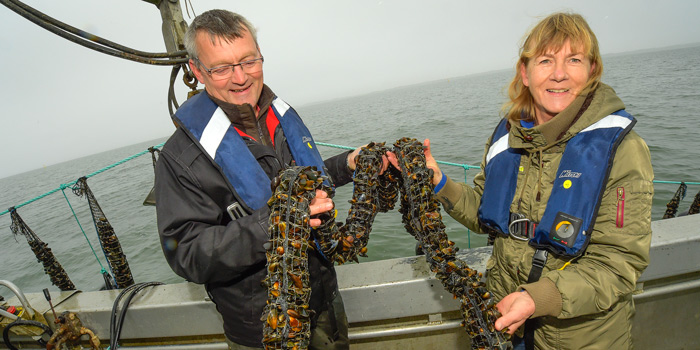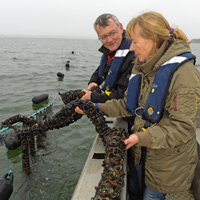The Danish Shellfish Centre on the island of Mors is the co-founder of a new programme for people living in the Limfjord area: grow your own shellfish in the fjord.
The Limfjord is liberally scattered with the finest and tastiest oysters and mussels in the world, and the residents of the four towns and cities close to the fjord now have the chance to create small ‘allotments’ where they can cultivate and harvest the tasty shellfish, along with a little ‘garnish’ in the form of seaweed. Carsten Fomsgaard Nielsen, a biologist from Danish Shellfish Centre—which is a part of DTU Aqua—was involved in establishing the programme and serves as a consultant to the fjord garden associations.
The gardens need neither watering or weeding in the conventional sense, it is simply a matter of removing any unwanted creatures from the lines. So it is quite easy to become a shellfish farmer, and today—not long after the ‘Fjord gardens in the Limfjord’ project was launched—each of the four associations has between 50 and 100 members.
The ‘allotments’ can take the form of a clearly marked area featuring long lines running a fair way out into the water, or a series of small platforms onto which the ‘farmer’ can walk directly. In Nykøbing Mors, for example, the farm comprises four 250-metre lines, on which are suspended ‘stockings’ filled with mussels that the Danish Shellfish Centre collected in May. Later on, the plan is for the associations themselves to hang out the bunches for the mussel larvae to attach themselves to. The mussels grow large enough—and mature sufficiently—to eat over the course of a year.
The oyster larvae are collected on small plastic discs (also called ‘Chinese hats’) and then placed in trays. They grow to edible size in three to four years.

President Peter Kristensen and Treasurer Mette Jensen of the Nykøbing Mors Fjordhave Association. Photo: Morsø Folkeblad.
If you would like to supplement the protein with a vegetable element, you can buy small seaweed plants on long tracking lines for installing during the autumn; the mature plants are ready for harvesting eight months later. Cultivating both seaweed and mussels is otherwise beneficial for the aquatic environment, because the plants ingest nutrients from the water and convert them into beneficial proteins, while the lines serve as a type of ‘suspended reef’ for a variety of creatures.
The Limfjord Council has applied for—and been granted—funding for the project from the Nordea Fonden foundation, and the Danish Shellfish Centre is responsible for establishing the installations. The centre also holds courses for the future fjord farmers, focusing on the actual cultivation process and on how to eliminate potential problems with food safety, given that foods cultivated in these gardens are not subject to classic food checks.
“In consultation with the Limfjord Museum, we pass on all necessary information about what happens during the year in a fjord garden, and about how to deal with any unwanted creatures,” relates Carsten Fomsgaard Nielsen, who is delighted with the new initiative that is giving plenty of people in North Jutland both interesting social experiences and good food for the table.

- The fjord gardens at Løgstør and Aalborg are quay-based installations in former harbour areas that are no longer in use.
- At Lemvig and Nykøbing Mors, long-line installations have been set up farther out in the fjord.
- Membership of the Fjord Gardens Associations costs DKK 300 per year.